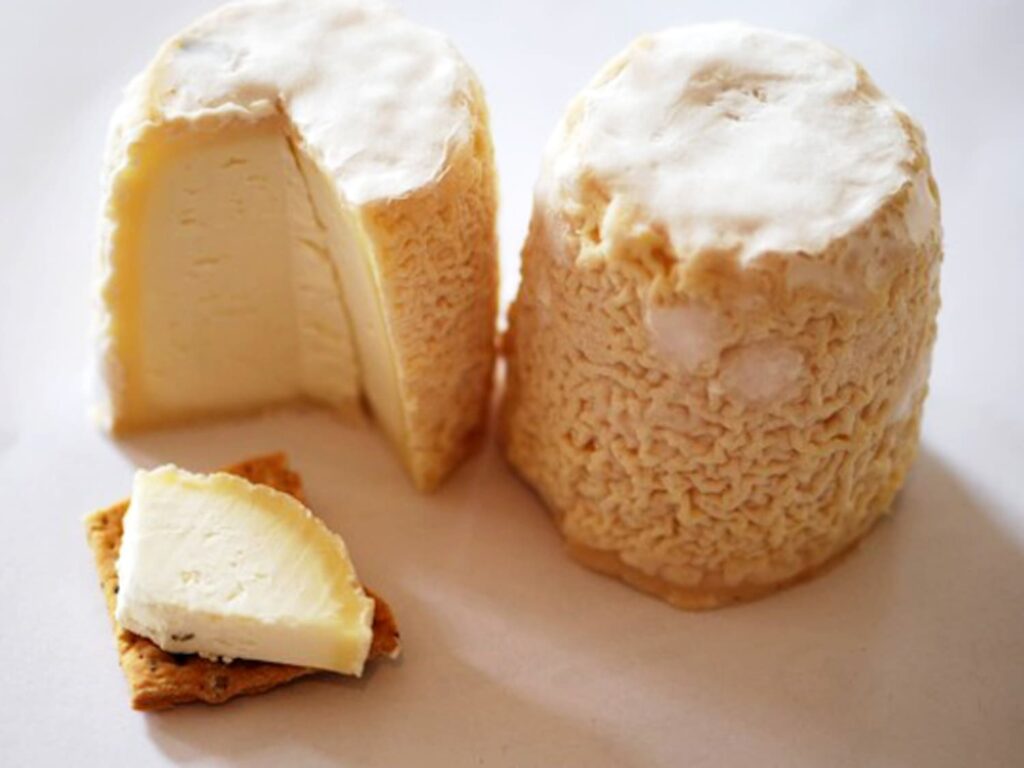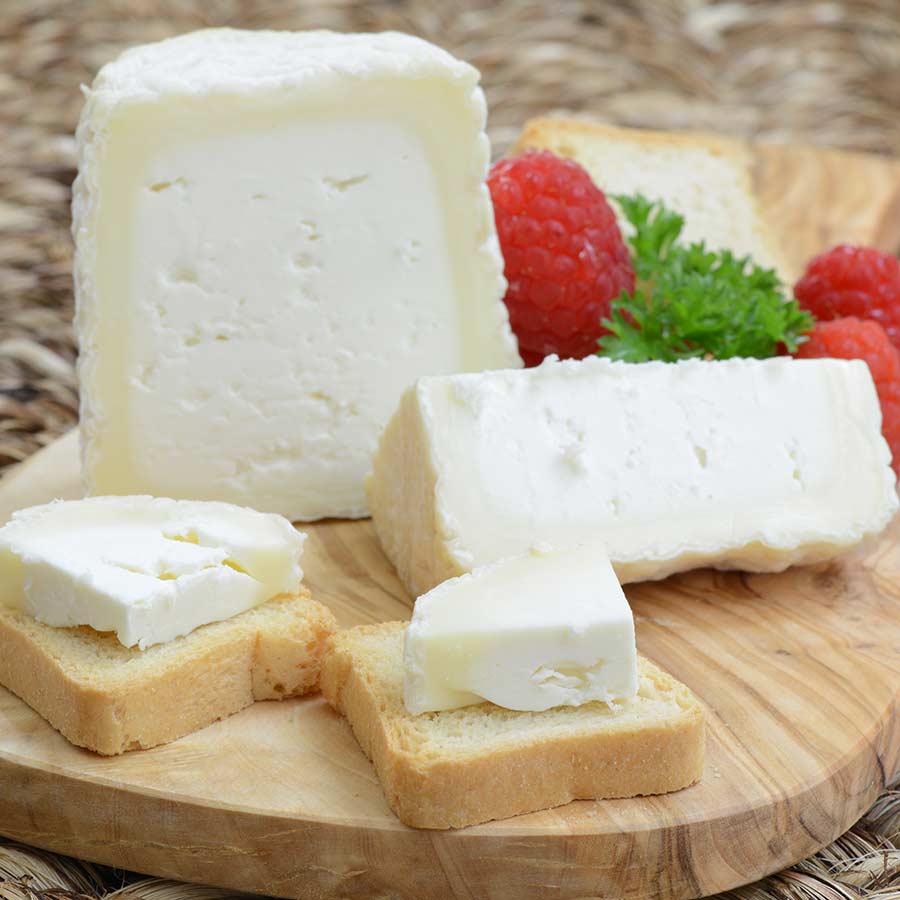What is Chabichou du Poitou? The Zesty, Grassy Cheese of France

Chabichou du Poitou is a zesty, grassy delight that is known for its deep mineral flavor. This goat cheese, often simply referred to as Chabichou, is a testament to France’s rich cheesemaking heritage. Its origins date back to the eighth century, illustrating an enduring appreciation for artisanal craftsmanship and quality ingredients.
This cheese hails from France’s acclaimed goat-breeding region, Poitou, and boasts a sweet, delicate, nutty taste. With a fat content of 45% and a requirement of at least several weeks to reach peak maturity, this cheese is a labor of love that results in a truly gourmet experience.
Quick Facts About Chabichou du Poitou
| Fact Category | Details |
|---|---|
| Origin | Poitou-Charentes region, France |
| Cheese Type | Soft, goat milk cheese |
| Appellation | AOC (Appellation d’origine contrôlée) since 1990 |
| Texture | Creamy and dense with a smooth, velvety rind |
| Flavor | Nutty and slightly tangy with a hint of sweetness |
| Color | White to ivory in the interior with a natural, light gray rind |
| Aging Time | Minimum of 10 days |
| Shape | Small cylindrical “drum” or “bell” shape |
| Best Pairings | Fresh fruits, honey, nuts, and light-bodied white wines like Sauvignon Blanc |
| Nutritional Value | High in protein and calcium, low in fat and cholesterol compared to cow’s milk cheeses |
What is Chabichou du Poitou?

Chabichou du Poitou, a delightful cheese hailing from the verdant pastures of France’s Poitou-Charentes region, is a splendid symbol of the country’s rich culinary heritage. This cheese, renowned for its delicate yet distinctive flavor profile, has been a cherished part of the French gastronomic landscape for centuries.
Crafted solely from goat’s milk, Chabichou du Poitou is a soft cheese that boasts a dense and creamy texture. Its smooth, velvety rind encases an interior that ranges from white to ivory in color. When you take a bite, you’re greeted with a slightly tangy and nutty flavor with a hint of sweetness—a testament to the lush grazing lands where the goats are reared.
What sets Chabichou du Poitou apart is not only its flavor but also its unique shape. The cheese is formed into small cylindrical “drum” or “bell” shapes, making it instantly recognizable. It is aged for a minimum of 10 days, allowing the flavors to intensify and the characteristic rind to develop.
In 1990, Chabichou du Poitou was awarded the AOC (Appellation d’origine contrôlée) designation, a recognition of its quality and adherence to traditional cheese-making methods. This means that every step of the production process, from the feeding of the goats to the aging of the cheese, occurs within the designated geographical area and follows strict guidelines.
Pairing Chabichou du Poitou is a joy. Its nuanced flavors complement fresh fruits, honey, nuts, and light-bodied white wines like Sauvignon Blanc, making it a versatile addition to any cheeseboard.
The truth is that Chabichou du Poitou is more than just a cheese. It’s a tribute to time-honored French tradition, a celebration of regional biodiversity, and a testament to the art of cheese-making. Whether you’re a seasoned cheese connoisseur or a curious food enthusiast, Chabichou du Poitou is sure to leave a lasting impression on your palate.
What Does Chabichou du Poitou Taste Like?
Chabichou du Poitou is celebrated for its unique and nuanced flavor profile. The taste of this cheese can be described as slightly tangy, nutty, and subtly sweet, which reflects the natural diet of the goats whose milk is used to produce it.
Upon first taste, the cheese imparts a mild acidity that quickly gives way to more complex flavors. The heart of the cheese reveals a deep, nutty taste that’s beautifully balanced by a hint of sweetness. Some people even detect faint notes of grass or hay, a nod to the lush pastures where the goats graze.
The rind of the Chabichou du Poitou, which is entirely edible, adds another layer of flavor. It has a more earthy and yeasty taste that contrasts nicely with the creamy and smooth texture of the interior.
As the cheese ages, these flavors continue to develop and intensify, resulting in a richer, more concentrated taste experience.
In terms of texture, Chabichou du Poitou is dense and creamy, providing a delightful mouthfeel that complements its flavor perfectly. This makes it a versatile cheese that can be enjoyed on its own, paired with fruits and nuts, or used to add depth to a variety of dishes.
Chabichou du Poitou Tasting Notes

- Initial Taste: Upon first taste, Chabichou du Poitou imparts a mild tanginess. This slight acidity is characteristic of goat’s milk cheeses and sets the stage for the more complex flavors to follow.
- Primary Flavors: The heart of the cheese reveals a deep, nutty flavor that’s balanced by a subtle sweetness. These primary flavors are the essence of Chabichou du Poitou and reflect the quality of the milk and the cheese-making process.
- Secondary Notes: Some people may detect faint notes of grass or hay, a nod to the lush pastures where the goats graze. These secondary notes add depth and complexity to the overall flavor profile.
- Rind Flavor: The rind of Chabichou du Poitou, which is entirely edible, brings an earthy and yeasty taste to the table. It provides a nice contrast to the creamy interior and adds another layer of flavor.
- Texture: Chabichou du Poitou has a dense and creamy texture. This delightful mouthfeel complements the cheese’s flavor perfectly and enhances the overall tasting experience.
- Aging Effects: As the cheese ages, its flavors continue to develop and intensify. An aged Chabichou du Poitou will have a richer, more concentrated taste, with the nuttiness and sweetness becoming more pronounced.
How to Eat Chabichou du Poitou?
Enjoying Chabichou du Poitou is a delightful culinary experience and there are several ways to savor this unique cheese:
- On Its Own: Due to its rich, nuanced flavor profile, Chabichou du Poitou can be enjoyed on its own. This allows you to fully appreciate its taste and texture.
- Cheese Platter: Include it in a cheese platter with a variety of other cheeses. Pair it with fresh fruits like apples and pears, nuts like walnuts or almonds, and some honey or fig jam. The contrasting flavors will enhance the tasting experience.
- With Bread or Crackers: Spread it on a slice of baguette or artisanal crackers. Its creamy texture makes it perfect for spreading.
- Wine Pairing: Pair it with a light-bodied white wine like Sauvignon Blanc or a fruity rosé. The acidity and fruitiness of these wines complement the tangy, nutty flavors of the cheese.
- In Cooking: Use it in cooking to add depth of flavor to dishes. It melts well and can be used in gratins, quiches, or salads. It’s also delicious when baked and served warm.
- Dessert: For a simple, elegant dessert, serve Chabichou du Poitou with a drizzle of honey and a sprinkle of crushed nuts.
10 Best Chabichou du Poitou Substitutes
| Substitute | Description |
|---|---|
| Chevre | This is a general term for goat cheese in French. It has a similar tangy taste to Chabichou du Poitou and can be used interchangeably in most recipes. |
| Feta | A Greek cheese that is tangy and salty. It’s a good substitute if you’re looking for a cheese that can hold its shape in salads or baked dishes. |
| Ricotta | An Italian cheese that is creamy and slightly sweet. It’s a good substitute if you’re looking for a milder flavor. |
| Crottin de Chavignol | Another French goat cheese that is more intense in flavor but has a similar texture to Chabichou du Poitou. |
| Boursin | A creamy, spreadable cheese that is often flavored with herbs and garlic. It can be used as a substitute in recipes that call for a spreadable cheese. |
| Camembert | A French cow’s milk cheese that is creamy and mild. It’s a good substitute if you’re looking for a less tangy flavor. |
| Goat Brie | It has a creamy texture similar to Chabichou du Poitou but with a milder flavor. It’s a good substitute in recipes that require melting cheese. |
| Roquefort | A French blue cheese made from sheep’s milk. It’s a good substitute if you’re looking for a stronger, more pronounced flavor. |
| Goat Gouda | It has a smooth texture and a sweet, nutty flavor. It’s a good substitute if you’re looking for a cheese that can be easily sliced or grated. |
| Pouligny-Saint-Pierre | Another French goat cheese with a similar shape and texture to Chabichou du Poitou. |
What Pairs Well With Chabichou du Poitou?

Food that goes well with Chabichou du Poitou:
| Category | Food Items |
|---|---|
| Fruits | Apples, Pears, Grapes, Figs, Apricots |
| Nuts | Walnuts, Almonds, Hazelnuts |
| Bread/Crackers | Baguette, Multigrain bread, Artisanal crackers, Rye bread |
| Charcuterie | Prosciutto, Salami, Smoked salmon |
| Condiments | Honey, Fig jam, Olive tapenade, Apple or Pear compote |
| Vegetables | Roasted peppers, Grilled asparagus, Marinated artichokes, Olives |
| Sweets/Desserts | Dark chocolate, Berries, Dried fruits like apricots, dates or raisins, French pastries like tarts |
Also read: What Fruit Goes on a Charcuterie Board?
Beverage that goes well with Chabichou du Poitou:
| Category | Beverage Items |
|---|---|
| White Wine | Sauvignon Blanc, Chardonnay, Chenin Blanc, Vouvray |
| Red Wine | Light-bodied reds like Pinot Noir, Beaujolais |
| Rosé Wine | Dry rosé wines, especially those from the Loire Valley |
| Sparkling Wine | Champagne, Prosecco, Cava |
| Dessert Wine | Sauternes, Late Harvest Riesling, Ice Wine |
| Beer | Belgian-style Saison, Wheat Beer, Light Ales |
| Cider | Dry apple cider, Pear cider |
| Non-Alcoholic | Sparkling water, Grape juice, Apple juice |
Also read: Best Wine and Cheese Pairings: The Ultimate Guide
Frequently Asked Questions
1. How to pronounce Chabichou du Poitou?
The pronunciation of “Chabichou du Poitou” in French can be broken down as follows:
- Chabichou: Sha-bee-shoo
- du: dyu
- Poitou: Pwa-too
So, put together, it would sound like “Sha-bee-shoo dyu Pwa-too”. Please note that the ‘u’ in ‘du’ is pronounced like the ‘u’ in ‘flute’, and not like the ‘u’ in ‘duck’.
2. How to store Chabichou du Poitou?
Storing Chabichou du Poitou properly is essential to maintain its unique flavor and texture. Here’s how to do it:
- Temperature: Like most cheeses, Chabichou du Poitou should be stored in a cool place. The ideal temperature is between 4°C (39°F) and 8°C (46°F). The vegetable drawer in your refrigerator often provides the right conditions.
- Wrapping: Wrap the cheese in parchment or waxed paper first, then loosely in plastic wrap or foil. This allows the cheese to breathe while also preventing it from drying out.
- Separation: Store the cheese separately to prevent it from absorbing the flavors of other foods in your fridge. A cheese storage box or a designated area in your fridge can work well for this purpose.
- Timing: It’s best to consume Chabichou du Poitou within a week of purchase. If you notice any mold growth that’s not characteristic of the cheese (Chabichou du Poitou has an edible wrinkled rind), it’s time to discard it.
Remember, always let the cheese come to room temperature before serving to fully enjoy its flavor profile. Enjoy your journey into the world of French cheeses!
Also read:
- What is Stracchino (Crescenza)? The Creamy Treasure of Northern Italy
- What is Ossau-iraty? Exploring a Classic from the French Pyrenees
- What is Fourme de Montbrison? The Gentle Blue From Southern France
- What is Laguiole Cheese? An Iconic French Delicacy
- What is Maroilles? A Taste of French Heritage
- What is Saint Nectaire? A Taste of the Auvergne Region’s Volcanic Pastures
- What is Tome des Bauges? The Art of Artisanal Cheese





